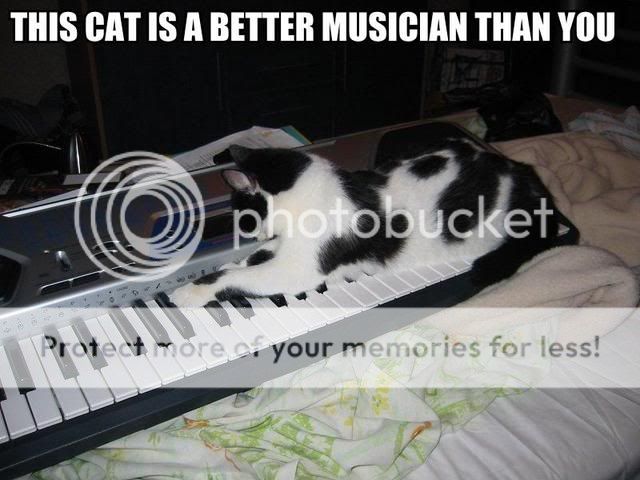&cWell, it's Sunday afternoon and time for the round-up of the Bad Kitty Chaos Festival #4. The theme is Music and Cats, and Luna starts us off with a “CatSynth pose” next to a soon-to-be-bent Casio SK-10:

 Meanwhile, Willow from sammawow has her own keyboard shot, where she channels the Ramones. Gotta love those 70s haircuts. We will probably feature some more photos of Willow as part of our regular “CatSynth pic” series.
Meanwhile, Willow from sammawow has her own keyboard shot, where she channels the Ramones. Gotta love those 70s haircuts. We will probably feature some more photos of Willow as part of our regular “CatSynth pic” series.
Luna doesn't really play much, she mostly just likes to hang in the studio, as we've seen many times in the past:
 For Gree, music is about purrrs. Purrs can indeed be a wonderful musical sound, there are several electronic treatments of purrs in the album I am currently working on entitled 2 1/2.
For Gree, music is about purrrs. Purrs can indeed be a wonderful musical sound, there are several electronic treatments of purrs in the album I am currently working on entitled 2 1/2.
Next we take a little detour from art towards science. Living the Scientific Life asks the question “Can Animals Predict Impending Death?”, and features the much discussed case of Oscar who seemed to predict when residents at a nursing home were near death.
Oscar is also the subject of this week's contribution by TherapyDoc.
 More music (or “mewsic”) can be found at the home of Kashim and Othello, where the boys try their own version of a faux reggae classic.
More music (or “mewsic”) can be found at the home of Kashim and Othello, where the boys try their own version of a faux reggae classic.
Meanwhile Victor Tabbycat presents Fursday along with Bonnie Underfoot.
 Those Bengals are back, with all the Bengal cuteness, over at Pet's Garden Blog.
Those Bengals are back, with all the Bengal cuteness, over at Pet's Garden Blog.
Mouse takes on the competition in this slideshow at This, That and The Other Thing (who hosted Carnival of the Cats last weekend). Don't worry Mouse, the toys are no match for you.
“When you?ve gotten bored of attacking your toys, there?s always your own foot to play with…”, as we are reminded at Dophin's Dock. Sage advice.
 Have you ever considered a cat's whistkers? Well, you should. And this contribution from the Magick Cat Cauldron will help introduce you this amazing piece of feline machinery.
Have you ever considered a cat's whistkers? Well, you should. And this contribution from the Magick Cat Cauldron will help introduce you this amazing piece of feline machinery.
Samantha says thank you to everyone who helped with her surprise party. Sounds like it was a smashing success.
At Self Help for Cats, Herman Panther likes to sleep cuddled with his humans, “like a lover.” Reminds me of a bit of “kitty live” with our own little panther here, who loves to snuggle up in bed on my left side and fall asleep purring.
 Aloysius joins our cats-and-music theme with his epic poem. Sing, Great Cat, the tale of Aloysius, mighty hunter of the line of Pangur Ban!.
Aloysius joins our cats-and-music theme with his epic poem. Sing, Great Cat, the tale of Aloysius, mighty hunter of the line of Pangur Ban!.
Gemini sets off a bit of an argument at Chey's Place. Maybe time for her own blog? After all, there is no such thing as too many cat blogs.
Over at the Cat Realm, Karl dares us all with a challenge. Visit them to find out more. Oh, by the way, nice shades!

Finally, Biscuit has not come home, and Megan and bad kitty cats are losing hope that she will return. This is really sad news for our friends who started this “festival” – we hope that she does defy the odds and return, but our sympathies are with them now.
Thanks to everyone who participated in this week's Bad Kitty Cat Festival of Chaos. Next weekend, we'll be hosting the old favorite Weekend Cat Blogging.














